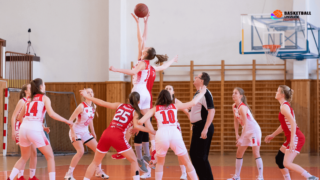
Are you curious about how much time your young basketball star will spend on the court during their exciting middle school basketball games? You’ve come to the right place! In this fun yet professional blog post, we will be diving headfirst into the world of middle school basketball and dissecting the ins and outs of game lengths. So, buckle up, grab your virtual whistle, and get ready for a slam dunk of information that will turn you into the ultimate middle school basketball game time expert!
How Long Are Middle School Basketball Games?
Middle school basketball games typically last around 60 to 90 minutes. Games consist of four quarters, each lasting 6 to 8 minutes, with breaks in between. There is a halftime break, usually 10 to 15 minutes long, and timeouts can also influence the total game duration.
Breaking Down the Middle School Basketball Game Structure
When it comes to middle school basketball games, one can’t overlook the importance of understanding the game’s structure. Not only does this aid in anticipating the overall length of the game, but it also provides valuable insight into the flow and rhythm of each match. Let’s explore some key components of the typical middle school basketball game structure.
Quarters and Timing
At the middle school level, basketball games generally consist of four quarters, each lasting between 6 to 8 minutes. The exact length of the quarters may vary depending on the league or region, so it’s essential to familiarize yourself with your local rules. Quarters provide a natural break in the action and allow coaches and players to review strategies, catch their breath, and make necessary adjustments.
Halftime: Rest and Reflection
Between the second and third quarters, a halftime break lasting 10 to 15 minutes is usually observed. This break serves as an essential opportunity for teams to regroup, recharge, and refine their strategies before returning to the court. Halftime helps maintain the game’s high energy and allows for a healthy balance of athleticism and learning.
Timeouts: A Needed Reprieve
Timeouts are another integral component of the middle school basketball game’s structure. Each team is generally allotted a specific number of timeouts per game, ranging from three to five. Timeouts last about 1 to 2 minutes and can be strategically used by coaches throughout the game to address various issues, make substitutions, or provide players with a momentary respite. Remember, the number of timeouts and their duration may vary, depending on the league or region, so be sure to familiarize yourself with local regulations.
Digging into a Standard Middle School Basketball Game Schedule
Now that we have a firm grasp of the game’s structure, it’s important to understand how a standard middle school basketball game schedule pans out. This knowledge will undoubtedly enrich your game day experience, getting you up to speed with crucial game moments and allowing you to standout as an informed and supportive spectator.
Pregame: Warm-Ups and Introductions
Pregame preparations are crucial in setting the stage for a successful and enjoyable basketball game. Middle school basketball games usually allow teams 15 to 30 minutes for warm-ups, drills, and last-minute team discussions. This warm-up period is essential for players to loosen up, reduce the risk of injury, and mentally gear up for the game. Pregame events often conclude with starting lineup introductions, adding a sense of excitement and anticipation to the atmosphere.
Quarter-by-Quarter: The Heart of the Game
At this point, spectators and players alike are hooked into the game, experiencing the journey of victory or defeat, one quarter at a time. As previously mentioned, middle school basketball games typically feature four quarters lasting 6 to 8 minutes each. Quarter breaks are generally 1 to 2 minutes long, offering players a brief reprieve before diving back into the action. During quarters, key events include executing planned plays, dazzling with skillful dribbling, and ultimately, driving toward the hoop for powerful layups or awe-inspiring slam-dunks.
The Clock Stops and the Free Throws
While the quarters themselves have a set time, it’s important to note that the game clock periodically stops throughout the match. These pauses occur during various situations, such as when a player is fouled, the ball goes out of bounds, or a timeout is called. In some cases, when a player is fouled while attempting a shot, they may be awarded free throws. Each successful free throw adds crucial points to the team’s score, which can make or break a close game. The game clock stays stopped during free throws, causing game time to extend beyond the initial quarter lengths.
A Deeper Dive: Rules, Referees, and Running Time
Recognizing that basketball is a game of intricacies and learning, middle school basketball leagues often implement specific rules and adaptations to accommodate their young players. These rules may vary between leagues, but they play a vital role in shaping the length and flow of the game.
Running Time and Modified Game Clock
Some middle school basketball leagues employ a running time policy for certain game situations or specific periods of the game, such as the first three quarters. Under a running time condition, the game clock does not stop during most dead-ball situations. By implementing a running time clock, leagues can strike a balance between maintaining the game’s pace and giving players ample opportunities for development—even if it ultimately shortens the overall game duration.
Referees: Guardians of Fair Play
In middle school basketball games, referees serve a fundamental role in promoting fair play, ensuring the rules are followed, and maintaining the game’s pace. They are responsible for making tough calls, like fouls, violations, and timeouts. With precise knowledge of the game and hawk-like attention to detail, referees play a critical role in shaping middle school basketball games’ flow and length.
Preparation and Logistics: Maximizing Your Middle School Basketball Experience
With a comprehensive understanding of middle school basketball game lengths and structure, you can now maximize your game day experience! Excelling at the role of a supportive fan, you can arrive informed, prepared, and ready to cheer on your budding basketball stars.
Scheduling and Travel
Knowing that middle school basketball games typically last 60 to 90 minutes, ensure you plan your schedule accordingly. Consider factoring in additional time for pregame preparations, warm-ups, and travel to and from the game location. Keep in mind that in some instances, games could end earlier or stretch beyond the anticipated duration due to various unforeseen circumstances.
Healthy Snacks and Hydration
Thinking of ways to make the middle school basketball experience even better? Pack healthy snacks and sufficient water for both yourself and your young athletes. This simple strategy can make a huge difference, boosting energy levels and maintaining focus throughout the game.
Embracing the Spirit of Middle School Basketball Games
Middle school basketball games offer so much more than just learning the sport or developing skills. They are platforms for camaraderie, sportsmanship, and teamwork. As you sit on the edge of your seat, supporting your favorite middle school basketball team, remember that it’s the journey, the lessons, and the memories that matter most. So, soak up every moment and embrace the spirit of the game with pride, because a love for basketball all starts with these captivating middle school games.
Keep an Eye on Overtime
While we have covered the regular game length, it is essential to discuss the possibility of overtime in middle school basketball games. Tightly-contested matches can go into overtime, resulting in an extended match duration. Let’s explore the effects of overtime on the overall game time.
Overtime Procedure
Overtime occurs when the game is tied after the fourth quarter. Generally, middle school basketball overtime periods last 3 to 4 minutes. The exact duration of an overtime period can vary due to local or regional rules, so be sure to familiarize yourself with the regulations of your league. The game continues into additional overtime periods until the tie is broken, and a winner is determined after the conclusion of an overtime period.
Impact on Game Duration
Since overtime periods can extend game duration beyond regular-time limits, it is crucial to be prepared for instances where the game might run longer. This could affect your scheduling, travel plans, and other commitments. Plan accordingly by allocating extra time and resources for potential nail-biting finishes that can arise from overtime clashes.
Considerations for Tournament Play
While we have covered the duration of standard middle school basketball games, it is essential to discuss the unique aspects of tournament play that could shape the length of the game. Middle school basketball tournaments typically follow a different set of rules or incorporate specific adaptations in terms of game length and structure.
Tournament-Specific Rules
In basketball tournaments, game lengths could be adjusted to accommodate multiple games in a shorter time frame. Tournament games might feature shorter quarters, reduced timeouts, or modified running time provisions. The differences in gameplay duration need to be factored in when attending such events. Be sure to acquaint yourself with the tournament-specific rules, as this will help provide clarity on the exact game lengths and structure for the matches involved.
Back-to-Back Games: Stamina and Time Management
In tournament play, middle school basketball athletes could be playing multiple games on the same day or over consecutive days. This condensed format not only poses challenges in terms of stamina and fatigue management but also demands a keen focus on time management. It is critical for players, coaches, and parents to monitor games closely, manage rest and recovery times, and adhere to tight scheduling in such situations. An efficient approach to tournament play will help ensure athletes enjoy a well-rounded and rewarding basketball experience.
Further Resources for the Basketball Enthusiast
As you immerse yourself in the world of middle school basketball games, remember that there are various resources available to help deepen your understanding of the sport. These resources can be of immense help for both players and passionate supporters.
Rulebooks and Guides
Comprehensive rulebooks provide invaluable insight into the nuances of basketball, covering everything from fundamental rules to advanced game strategies. Consider consulting your local or regional rulebooks, as well as widely-recognized resources such as the National Federation of State High School Associations (NFHS) Basketball Rules Book for a deeper understanding of the game.
Coaching Clinics and Online Courses
For those looking to further their basketball expertise, coaching clinics and online courses offer a wealth of knowledge. These educational opportunities cover a wide range of topics, from coaching philosophies and player development to advanced game tactics. Engaging in such learning experiences can significantly enhance your appreciation for middle school basketball games and contribute to the overall growth and enjoyment of the sport.
Basketball Communities and Discussion Forums
Joining basketball communities or participating in discussion forums can be an excellent way to gain insights, tips, and advice from fellow basketball enthusiasts. Sharing experiences, discussing game tactics, and engaging with people passionate about the sport will contribute to a deeper understanding and appreciation for middle school basketball games.
Frequently Asked Questions
As you delve into the captivating world of middle school basketball games, you may have questions that touch on various aspects of the sport. In this FAQ section, we address some common questions related to middle school basketball game durations, rules, and more. Let’s dive in and clear up any lingering uncertainties.
1. How long are the quarters in middle school basketball games?
In middle school basketball games, quarters typically last 6 to 8 minutes each. The exact length may vary depending on the league or region.
2. Can middle school basketball games end in a tie?
No, middle school basketball games cannot end in a tie. If the game is tied after the fourth quarter, overtime periods are played until a winner is determined.
3. How long is halftime during middle school basketball games?
Halftime in middle school basketball games usually lasts 10 to 15 minutes, giving teams an opportunity to regroup and strategize before continuing the game.
4. How many timeouts are allowed in middle school basketball games?
The number of timeouts allowed in middle school basketball games typically ranges from three to five per team, depending on the league or regional rules.
5. Can middle school basketball games be shortened due to a running time clock?
Yes, some leagues may implement a running time clock for specific occasions or game periods, resulting in a shorter game duration to accommodate younger players or maintain the game’s pace.
6. How long does a middle school basketball game typically last?
Overall, middle school basketball games usually last around 60 to 90 minutes, including pregame, quarters, halftime, and any timeouts or stoppages.
7. How many players are on a middle school basketball team?
Middle school basketball teams typically have around 12 to 15 players, but the exact number may vary depending on the school, league, or coaching preferences.
8. How often are middle school basketball practices held?
Practice frequency varies depending on team scheduling and coaching decisions, but middle school basketball practices usually occur 2 to 4 times per week during the competitive season.
9. How long are overtime periods in middle school basketball games?
Overtime periods in middle school basketball games generally last 3 to 4 minutes, but the duration may depend on league or regional regulations.
10. What is the standard height of a basketball hoop in middle school games?
In middle school basketball games, the standard hoop height is 10 feet from the ground, which is the same as in high school, college, and professional basketball games.
11. What is the size of a middle school basketball court?
Middle school basketball courts typically measure 74 feet long by 42 feet wide, but dimensions may vary depending on the specific school or facility.
12. What type of basketball is used in middle school games?
Middle school boys typically use a 29.5-inch circumference basketball (official size), while middle school girls use a smaller 28.5-inch circumference basketball (intermediate size). The exact specifications may vary depending on the league or regional rules.
13. Are there different rules for middle school basketball compared to high school or college?
While middle school basketball rules generally align with high school and college rules, certain adaptations or variations might be applied to cater to younger players’ specific needs or the league’s preferences. Familiarizing yourself with your local or regional rulebooks is crucial for understanding any differences.
Featured Posts
- No pillar pages found.





